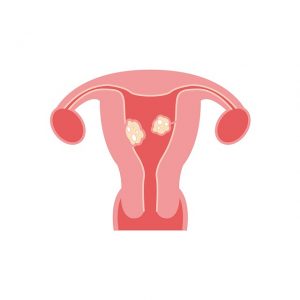What Are Fibroids
Just like the exact cause of fibroids, researches are not quite sure what causes them to grow. Yet most agree on likely causes. Fibroids, as we know, are usually benign tumors that grow in the muscular wall of the uterus. They can  range in size. Some fibroids can be smaller than peas while others can be as large as a grapefruit. They occur in many women during reproductive age. Symptoms are heavy and prolonged menstrual periods, pelvic pressure, frequent urination, constipation and leg or back pain. Some women may not experience any symptoms. While other women may get them confused with premenstrual syndrome, (PMS.) Growth and location are the main factors that contribute to common fibroid symptoms. But, the growth of fibroids is not always problematic. They become troublesome when they become large, cause painful symptoms or affect fertility.
range in size. Some fibroids can be smaller than peas while others can be as large as a grapefruit. They occur in many women during reproductive age. Symptoms are heavy and prolonged menstrual periods, pelvic pressure, frequent urination, constipation and leg or back pain. Some women may not experience any symptoms. While other women may get them confused with premenstrual syndrome, (PMS.) Growth and location are the main factors that contribute to common fibroid symptoms. But, the growth of fibroids is not always problematic. They become troublesome when they become large, cause painful symptoms or affect fertility.
Fibroid Development
Most researchers believe that each fibroid tumor develops from one mutant muscle cell inside the uterus. This problematic cell multiplies rapidly under the direct influence of estrogen and other female hormones. After some time, these abnormal cells overproduce large amounts of collagen to their proteins. In addition, many gene mutations occur in fibroid cells that alter and contribute to cell growth. Researchers believe environmental factors play a role in this rapid cell stimulation. Yet, this theory remains unclear.
muscle cell inside the uterus. This problematic cell multiplies rapidly under the direct influence of estrogen and other female hormones. After some time, these abnormal cells overproduce large amounts of collagen to their proteins. In addition, many gene mutations occur in fibroid cells that alter and contribute to cell growth. Researchers believe environmental factors play a role in this rapid cell stimulation. Yet, this theory remains unclear.
In order for fibroids to grow, the presence of two specific hormones– estrogen and progesterone are necessary. Yet, for them to develop full out, their presence is not enough. There needs to be an interaction of estrogen, progesterone and other cell growth factors. Estrogen and progesterone production begins around puberty. But, it is unusual for fibroid production to occur before or during this time.
Understanding Estrogen and Progesterone
Estrogen and progesterone are two hormones that are produced by a woman’s ovaries. Fibroid tissues will contain more estrogen and progesterone than normal uterine cells. When estrogen and progesterone upsurges, the uterus lining experiences restoration and regeneration. This occurs during each woman’s monthly cycle, to prep the body for pregnancy. These same two hormones also appear when promoting fibroid growth.
Pregnancy & Fibroid Growth
During pregnancy, you may see a dramatic increase in your fibroids. They can  increase in number and size. Why? This is due to the rise in a woman’s estrogen and progesterone levels during pregnancy. It’s not uncommon for a woman to quickly develop fibroids during the first trimester of her pregnancy. After development, they most often grow fast. These fibroids usually disappear on their own or shrink after you give birth. Even more so, fibroids will likely shrink during or after menopause. This is because hormone levels decrease.
increase in number and size. Why? This is due to the rise in a woman’s estrogen and progesterone levels during pregnancy. It’s not uncommon for a woman to quickly develop fibroids during the first trimester of her pregnancy. After development, they most often grow fast. These fibroids usually disappear on their own or shrink after you give birth. Even more so, fibroids will likely shrink during or after menopause. This is because hormone levels decrease.
Are My Hormone Levels Too High?
Learning about estrogen and progesterone may lead you to believe that  women with fibroids are making too much estrogen or progesterone. That’s a common myth. Estrogen and progesterone levels in a fibroid sufferer’s blood are almost always regular. Research shows that fibroids contain specific enzymes. These particular enzymes convert androgens into estrogen within the actual fibroid. Androgens are hormones made by the ovary and the adrenal gland. Because of this fact, the fibroid cell itself contains much higher levels of estrogen than the rest of the body. Plus fibroids are quite sensitive to the progesterone hormone. They thrive during a woman’s cycle when progesterone levels are abundant.
women with fibroids are making too much estrogen or progesterone. That’s a common myth. Estrogen and progesterone levels in a fibroid sufferer’s blood are almost always regular. Research shows that fibroids contain specific enzymes. These particular enzymes convert androgens into estrogen within the actual fibroid. Androgens are hormones made by the ovary and the adrenal gland. Because of this fact, the fibroid cell itself contains much higher levels of estrogen than the rest of the body. Plus fibroids are quite sensitive to the progesterone hormone. They thrive during a woman’s cycle when progesterone levels are abundant.
Growth Factors
Growth factors which are small proteins that affect cell growth have been shown to increase the growth promoting effects of estrogen. This plays an important role in fibroid development. These growth factors may include epidermal growth factor and insulin-like growth factor.
According to “What is Epidermal Growth Factor,” an article published in Bio Effect, epidermal growth factor (EGF) is
“…a type of naturally occurring protein molecule found in the skin’s fibroblast cells that contribute to cell growth, development and healing.”
According to the National Cancer Institute, an insulin-like growth factor is
“…a protein made by the body that stimulates the growth of many types of cells. The insulin-like growth factor is similar to insulin, a hormone made in the pancreas.”
Overall, estrogen, progesterone, and the above mentioned growth factors likely promote fibroid tumor growth. Yet this is only after the original initiation of fibroid tumor formation. How this formation originally occurs still remains uncertain. Yet recent developments contribute fibroid initiation to genetics, environment and diet. Also, researchers at the Center for Uterine Fibroids have identified mutations in two genes, HMGI(C) and HMGI(Y). These genes may be important in the development of some fibroids.
Moving Forward
Researchers and scientists continue to study the causes of fibroid cell growth. There is still not enough data on the cause and prevention of fibroids, yet there are many theories. Depending on the size, location and symptoms from uterine fibroids, a variety of treatment options may be available.


